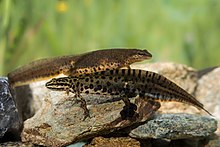Greek smooth newt
| Greek smooth newt | |
|---|---|

| |
| Female (background) and male during breeding season | |
| Scientific classification | |
| Domain: | Eukaryota |
| Kingdom: | Animalia |
| Phylum: | Chordata |
| Class: | Amphibia |
| Order: | Urodela |
| Family: | Salamandridae |
| Genus: | Lissotriton |
| Species: | L. graecus
|
| Binomial name | |
| Lissotriton graecus (Wolterstorff, 1906)[1]
| |

| |
| Range (hatching indicates unclear contact zones with L. schmidtleri )
| |
| Synonyms[2] | |
|
15 synonyms
| |
The Greek smooth newt or Greek newt (Lissotriton graecus) is a newt species found in the southern Balkans, from southern Croatia (Dalmatia) over Montenegro, Albania and North Macedonia to Greece and south-westernmost Bulgaria.[3][4]: 234
Willy Wolterstorff described the species in 1906 as Triton vulgaris graeca, a subspecies of the smooth newt.[1] After genetic data had suggested the smooth newt was a complex of distinct lineages,[5] Dubois and Raffaëlli, in 2009, recognised several subspecies, including the Greek smooth newt, as distinct species.[6] This was followed by subsequent authors.[2][3][7] Molecular phylogenetics suggested that the closest relative of the Greek smooth newt is Kosswig's smooth newt (Lissotriton kosswigi) from northwestern Anatolia.[7]
The species differs from other species in the smooth newt species complex mainly in the male secondary characters during breeding season.[3] The male dorsal crest is less than 1 mm high and has smooth edges. The belly has many small spots, but the lower tail fin is usually unspotted. The well-developed dorso-lateral folds give the body a square shape. Toe flaps on the hind feet are well developed.[4]: 234
The species's
References
- ^ a b Wolterstorff, W. (1906). "Über Triton vulgaris L. subsp. graeca". Zoologischer Anzeiger (in German). 29: 137–139.
- ^ doi:10.5531/db.vz.0001. Archived from the originalon 25 April 2020. Retrieved 25 April 2020.
- ^ doi:10.1163/15685381-17000128. Archived from the original(PDF) on 28 April 2019.
- ^ ISBN 9789004285620.
- S2CID 7484766.
- S2CID 85602660.
- ^ PMID 28797693.
